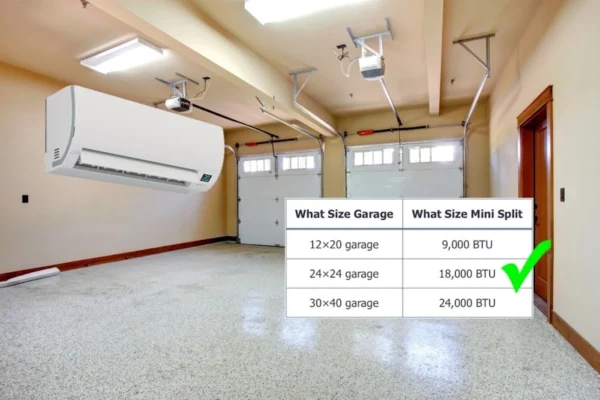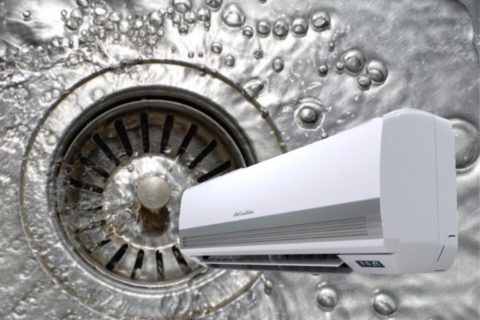Ducted Mini Split Guide: Basics, Comparison & Installation
Mini splits can be ducted. Mini splits don’t always have to be ductless. Since mini splits are new in certain regions, people have a lot of questions, particularly on ducted mini splits. So, I did extensive studies to try and answer all of the possible questions they have in mind.
First of all, mini splits indeed can be ducted. The indoor unit of the mini split system can be connected to HVAC ducts for air distribution. Such an indoor unit is known as a ceiling ducted unit. In other words, a ceiling ducted mini split uses HVAC ductwork to heat and cool a house.
Many people don’t realize that mini splits can actually be ducted. Hence, they miss out on the chance to improve the interior aesthetics of their house using ducted mini splits.
How Ducted Mini Splits Work?
As you might have already known, a mini split consists of two separate units; a) indoor unit (air handler) and b) outdoor unit. When it says ducted or ductless, it is actually referring to the indoor unit.
A ducted mini split works by distributing air through HVAC ductwork via a ceiling ducted indoor unit. The ceiling ducted unit is designed to be concealed above the ceiling. Its supply air outlet can be connected to a duct while its return air inlet can be connected to a plenum box or using a free return.
Many people don’t realize that a mini split has a few types of indoor units to choose from. The outdoor unit can be paired with different types of air handler listed as follow:
- Wall-Mounted Unit
- Ceiling Cassette Unit
- Ceiling Exposed or Suspended Unit
- Floor-Mounted Unit
- Ceiling Ducted or Concealed Unit
Each type of indoor unit has its own characteristics and applications. If you want to learn more about them, see my post 5 Types of Mini Split Indoor Units (How to Choose) where I explain further with photos.
Working Principle
The working principle of a ducted mini split is generally the same as a ductless mini split. So, I’ll keep it short here and brief you through.
It all starts with the compressor which is located inside the outdoor unit. The R410A refrigerant is compressed and flowed through the heat exchanger of the outdoor unit for heat rejection.
Next, the refrigerant flows to the indoor unit via a set of copper tubes. At the indoor unit, the refrigerant is expanded by a metering device (expansion valve) and flowed through the heat exchanger of the indoor unit for cooling.
Most mini splits can do both heating and cooling. Hence, when you change the mode to heating using the remote controller, the reversing valve located inside the outdoor unit will reverse the whole process.
Ceiling Ducted Unit Explained
The difference between a ducted mini split and a ductless mini split is the indoor unit. While the indoor unit of a typical ductless mini split is known as a wall-mounted unit, the indoor unit of a ducted mini split is known as a ceiling ducted unit.
Ceiling ducted units are designed to be installed above the ceiling. Hence, they don’t look as good as wall-mounted units because it is unnecessary. Still, they perform just as well.
Let’s take a look at a typical ceiling ducted unit as follow:

At a glance, a ceiling ducted unit has a large opening at the front and a filter at the back. The front opening is for you to connect a duct for supply air and the back can be connected to a return air plenum box if you planning to do a ducted return (more on return air later in this post).
Next, the unit has four support brackets for you to hang from the soffit slab using galvanized iron (GI) rods. Then, there are three pipe connection ports; two for the refrigerant pipes and one for the drain pipe.
Ducted Mini Split Installation
The installation of a ducted mini split is very different from a ductless mini split. Ducted mini splits require ductwork for air distribution.
The amount of ductwork for a ceiling ducted unit varies based on applications. When a typical ceiling ducted unit is installed and connected to a duct, it’ll look something like this:
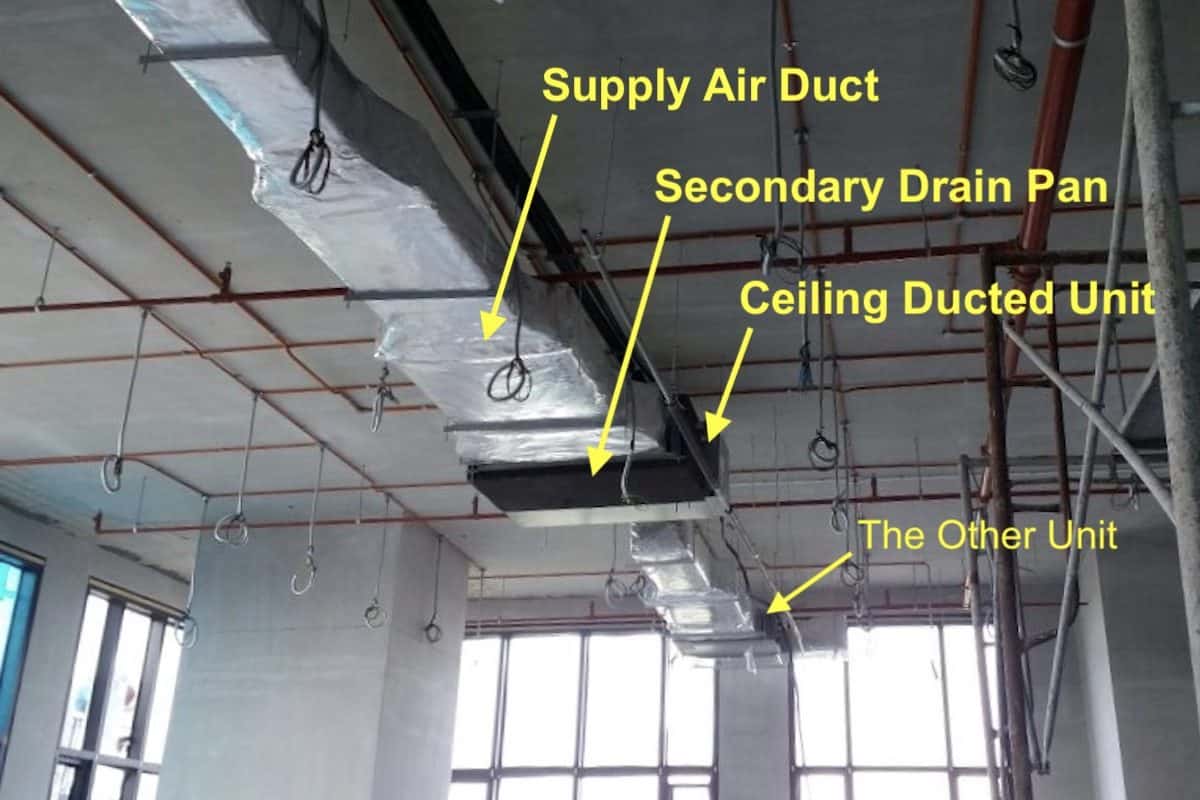
From the above photo, the supply air duct is a rectangular duct rather than a flexible round duct. It looks wrinkly and shiny because of the external fiberglass insulation.
Under the ceiling ducted unit is a secondary drain pan. It looks dark due to the grey color polyethylene (PE) insulation. A secondary drain pan is an optional accessory for extra protection in case the built-in drain pan is clogged so that the ceiling won’t get damaged by water leakages.
Relevant post: Air Conditioner Condensate Drain Pipe Installation Basics.
After that, when the ceiling ducted unit is installed with flexible branch ducts and supply air plenum boxes, it’ll look something like this:
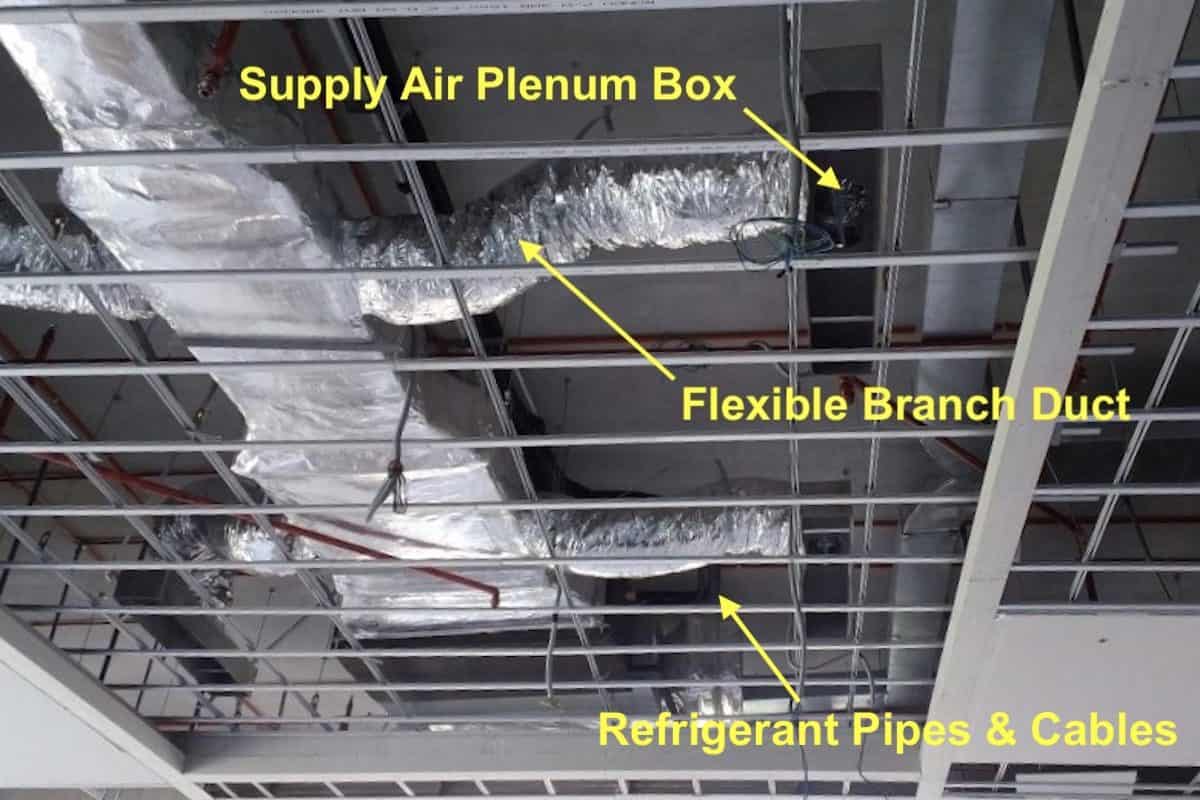
Before the plaster ceiling is installed, we usually get the flexible ducts and plenum boxes ready in position. The position of the supply air plenum box will be the position of the supply air diffuser.
The supply air diffuser used in the above photo is a 3-slot 1200mm linear diffuser. However, there are a few other types of diffusers you can choose from based on your preferences and applications. To learn more about them, see my post 6 Types of Supply Air Diffusers and Their Applications.
Also, is kinda hard to see but notice that the refrigerant pipes and cables are also connected to the ceiling ducted unit. As for the drain pipe, it is connected to both the drain outlet of the unit itself as well as the secondary drain pan.
So, when the ceiling is closed and the supply air diffusers are installed, it’ll look something like this:
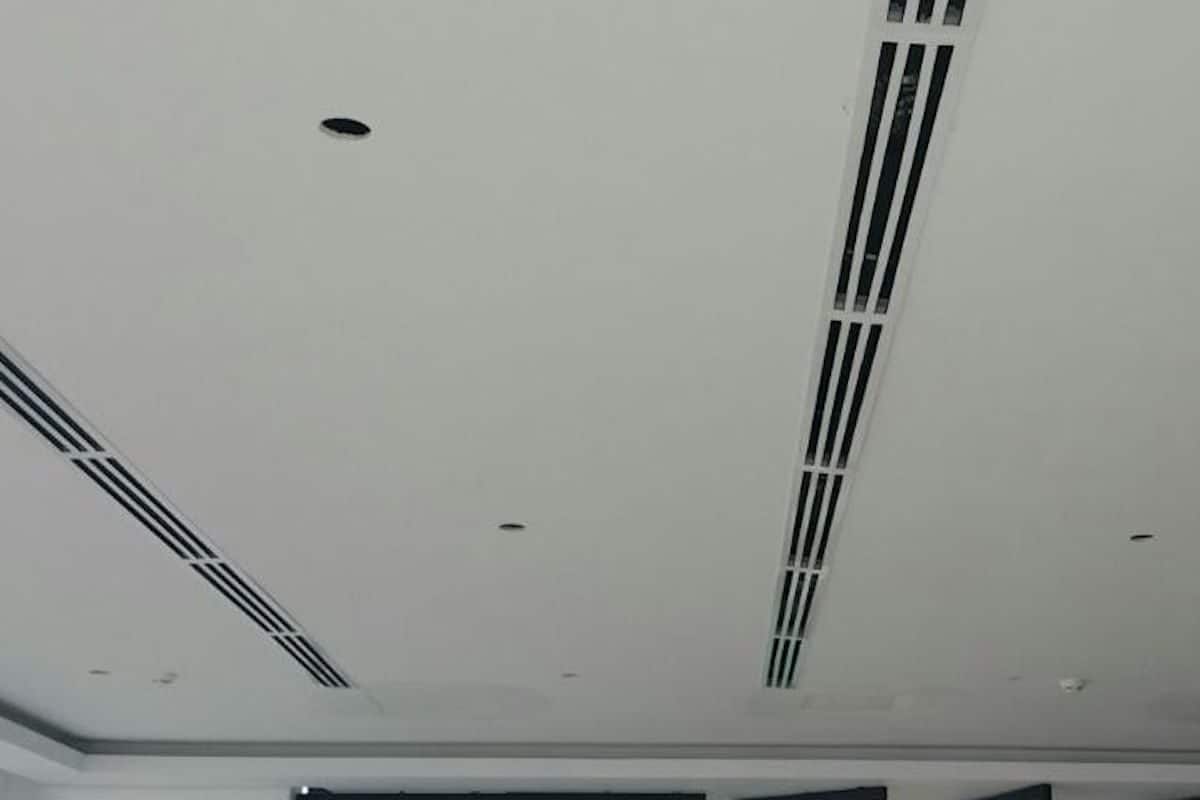
If we zoom out to see the entire room, we’ll have an elegant looking room like this:

Notice that there are only a few supply air plenum boxes shown earlier but the quantity of the linear diffuser seems to be more than that. It is because not all linear diffusers are used for the supply air.
Some of the linear diffusers are used for the return air and so, the ceiling ducted unit is using a free return instead of a ducted return. But, what is a free return?
Basically, a free return doesn’t have return air ducts. Often, there is nothing connected to the back of the ceiling ducted unit for a free return. Sometimes, we do connect a return air plenum box at the back of the ceiling ducted unit when fresh air is introduced.
For the fresh air connection to the ceiling ducted unit, see my post How to Ventilate a Room with Air Conditioner? where I show a quite detailed sketch but using a ceiling cassette unit as an example. However, the method is the same and it is a good reference.
Thermostat Control
While a ductless mini split controls the room temperature via a built-in temperature sensor or the remote controller, you can opt for a remote controller or a wired controller for a ducted mini split.
For wired controls, the wired controller also serves as the thermostat. With a wired controller, you can set the room temperature, fan speed, operation mode, schedule and check error codes. Meanwhile, you also can use a wireless remote controller.
Although ducted units are usually found in centralized air conditioning systems, they now can be used in small individual decentralized air conditioning systems like the mini split system.
By the way, if you want to learn more about mini split especially how to design it for your house, consider my Mini Split (eBook). You’ll learn what is Mini Split, how to choose and more importantly, spark more design ideas to improve the energy efficient of your house. But, if you need a second opinion or want someone to help you design, then you can consider my consultation service.
Consultation Service
Ask me for HVAC advice such as brand selection, best model, benefits, features, placement, duct size, grille size, how to design, design check, verification and other HVAC related queries.
Ducted Mini Split vs Ductless Mini Split
Now that you know what is a ducted mini split. So, should you choose to use a ducted mini split or a ductless mini split and also, what are the differences between the two?
Most of the time, the cost of ownership for a ducted mini split is higher than a ductless mini split. Ducted mini splits are usually more expensive to purchase, install and maintain. However, they provide a more luxury air conditioning experience with low noise operation and beautiful-looking diffusers.
Some people use a ducted mini split just for the living room while the rest of the room is using a ductless mini split. If you are also looking for something like this, the following are the pros and cons of the two.
Ducted Mini Split
Ducted mini splits are known for their incredibly quiet operation. Often, it is inaudible. Furthermore, they are the only type of mini split that concealed everything above the ceiling.
Pros
- Low Noise Operation
- Elegant Interior
- Centralized Control Compatible
Cons
- High Cost
- Complex Ductwork
- Less Efficient
The greatest advantage of a ducted mini split against a ductless mini split is the ability to be centralized. With the presence of ductwork, a single ducted mini split can serve multiple rooms. However, optional accessories must be included for zone temperature controls.
Ductless Mini Split
Ductless mini splits are known for their superior energy efficiency. Because there is no ductwork involved, energy losses are minimal but some people don’t like to see an air handler in their room.
Pros
- Low Cost
- High Efficiency
- Easy to Maintain
Cons
- Visible Air Handler
- Noisier at High Fan Speed
- More Units
The greatest advantage of a ductless mini split against a ducted mini split is low cost. Ductless mini splits are simple, easy to install and service. However, they can’t provide the kind of elegant and luxurious feel to the house.
See my post Most Efficient Mini Splits: Cooling, Heating & Different Types to compare the efficiency between ducted and ductless mini splits.
How to Install a Ducted Mini Split?
Apart from the basic installation of a ducted mini split itself, there are a few ways to install a ducted mini split. Let’s take a look at a few common ways to install a ducted mini split.
The Hotel Room Style
Most 4-star and 5-star hotels have a ceiling ducted unit in their guest rooms. Since hotel rooms are not big, the ceiling duct unit uses minimal ductwork.
Below is the typical layout of a ceiling ducted unit in a hotel room:
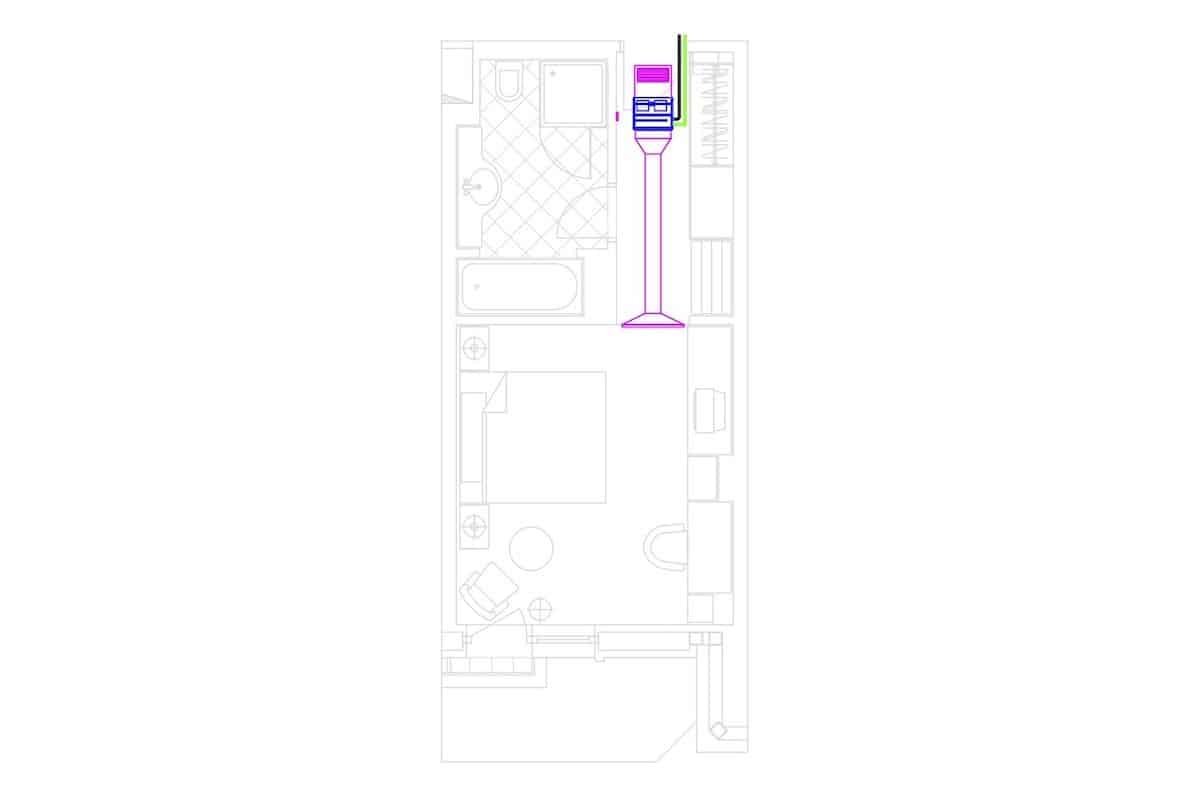
Notice that there is only one supply air outlet and one return air inlet. If we zoom in to see each and every component of the ceiling ducted unit, it’ll look like this:
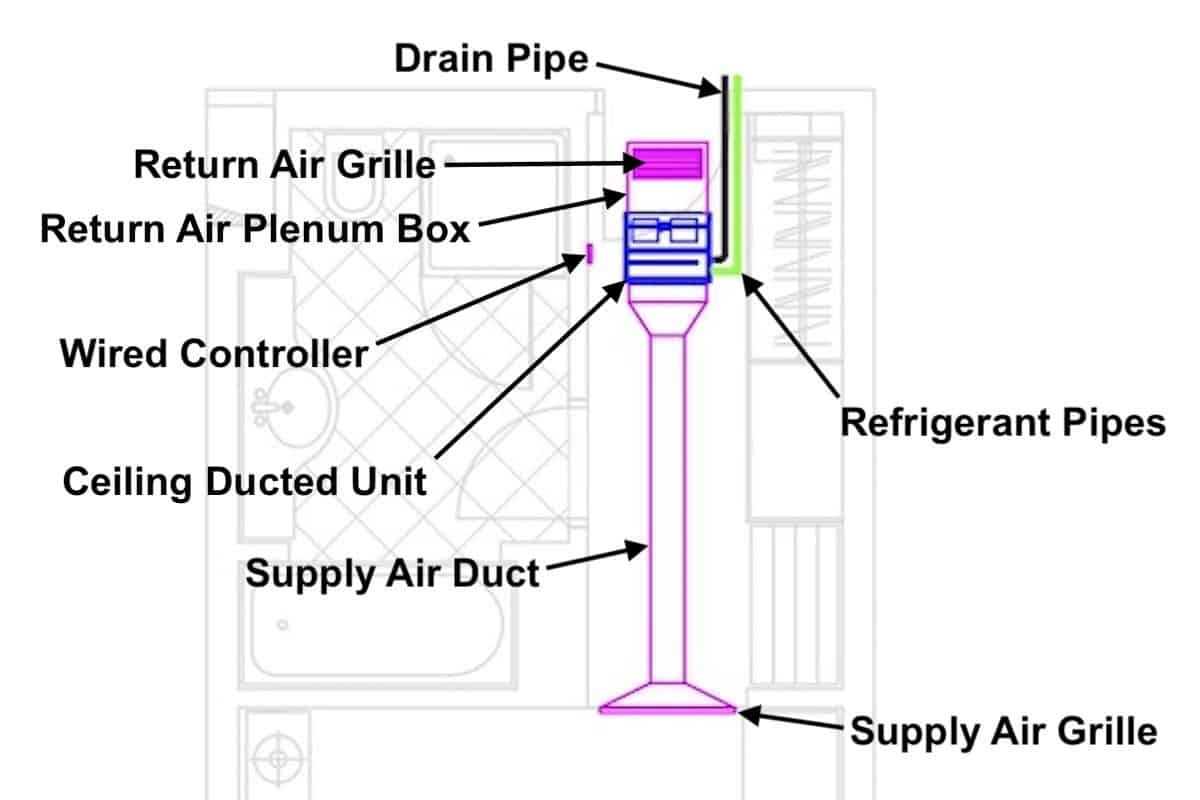
If you have a small room, you can follow the hotel style when installing a ducted mini split. Such a layout will incur minimal ductwork costs. In addition, you may insulate the supply duct and return plenum box internally to further reduce the noise of the air conditioning unit.
For more details about duct insulations, see my post 4 Types of Duct Insulations (with Specifications) and Duct Insulation Guide: How-to, Selection & Thickness.
When a ceiling ducted unit is installed like the above, your room will look something like this:
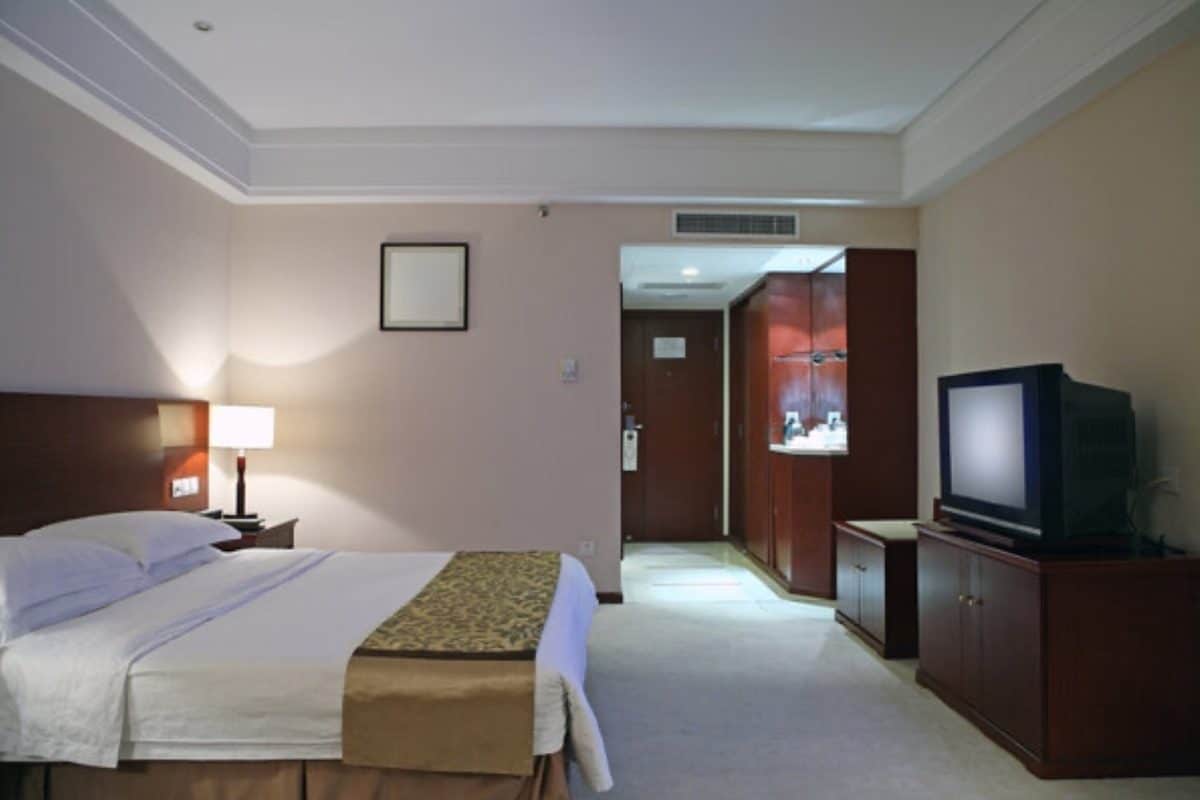
If you look closely, a return air grille can be spotted at the back, near the door while the supply air grille is at the front of the drop ceiling which is a typical layout you can find in hotel rooms.
Relevant post: How Hotel Air Conditioners Work?.
The U-Turn Style
For small rooms, you can save the cost of ductwork even more with the u-turn style. Without further ado, let’s take a look at the layout drawing as follow:

As you can see, the ceiling ducted unit can be rotated such that the supply and return grilles form a straight line on the drop ceiling. Such a layout required a longer ceiling length but it gives an even more grand/luxury feel to the room.
Once the ceiling ducted unit is done, it’ll look something like this:

A continuous grille is more desirable. Hence, a dummy grille that connects to nothing can be placed in between the supply and return grilles. Many hotels adopt this type of layout design.
The Conventional Way
A large capacity ducted mini split can be used to cool the entire house. However, you also can choose to install a small capacity unit individually in every room.
For a single unit ducted mini split, the layout will look something like this:
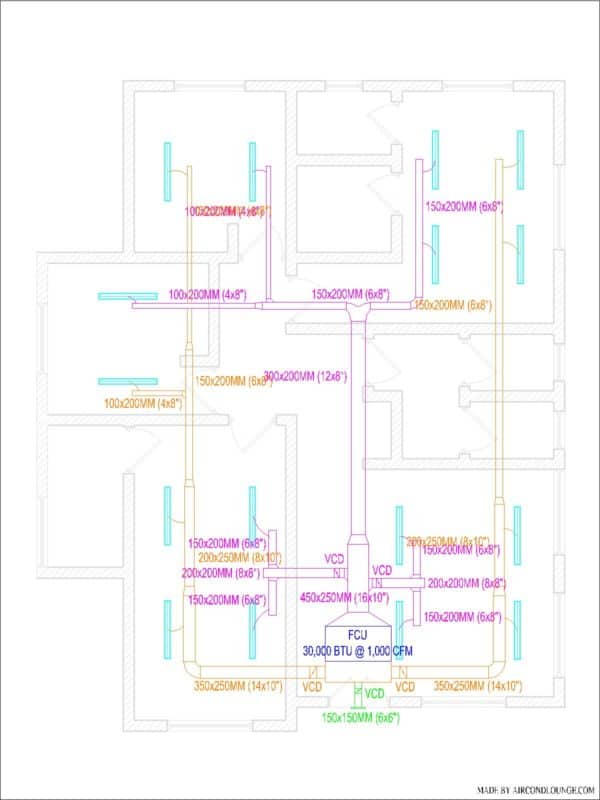
The above layout drawing came from my post HVAC Ductwork Design Guide (Layout, Duct Size & CFM). If you want to learn how to design HVAC ductwork, it is the perfect resource for you.
Can You Put a Ducted Mini Split in Unconditioned Attic?
Fundamentally, it is fine to put a ducted mini split in an unconditioned attic. After all, the space above the ceiling is also unconditioned. However, you need to pay more attention to the external static pressure of the ducted mini split unit.
Ducted air conditioners have their own rated external static pressure. It can be viewed as the strength of the fan to push air throughout the ductwork. Insufficient external static pressure may cause insufficient cooling in certain rooms due to low airflow, especially those that are far away from the air conditioner.
I’ve touched on the calculation of the external static pressure in my post HVAC Ductwork Design Guide (Layout, Duct Size & CFM). So, I encourage you to check it out.
In addition, too many flexible ducts are not recommended for ducted mini splits because the friction loss is very high and ducted mini splits don’t have enough external static pressure to overcome it. So, we usually limit the length of a single piece of flexible duct to below 2.5 m (8 ft).
When Should You Use a Ducted Mini Split?
If you don’t wish to see any air handler in your home, a ducted mini split is viable. Besides, large rooms are generally more suitable for a ducted mini split rather than a ductless mini split for balanced air distribution.
Using one ducted mini split to cool the entire house is often not recommended because you’ll have trouble controlling the temperature of each room since there is only one thermostat available.
However, some manufacturers have an optional accessory for you to install a sort of like a thermostat device in each room to better control the temperature. Nonetheless, it’s still difficult because the airflow supply to each room is fixed.
Although there are products that can regulate airflow in every room independently, they are mostly for commercial applications and often are too expensive for home use.
So, for residential applications, we usually design a wall-mounted ductless mini split for a small room. For a medium-sized room, we propose a ceiling cassette mini split. Then, for a large room like the living room, we’ll use a ceiling ducted unit.
In addition, a ceiling ducted unit is also available in the multi-zone mini split system as well as the VRF system rather than just for the single-zone mini split system. So, different types of indoor units can all be connected to a single outdoor unit if you opt for the multi-zone system or the VRF system.
Do Ducted Mini Splits Need a Return?
Ducted mini splits do need a return. However, whether or not you need a return duct or return plenum box is depending on your preferences and applications.
Relevant post: What is a Plenum Box? (Purpose on FCUs and Diffusers).
As mentioned earlier, you can install a return air plenum box like the hotel room style and use a single piece of return air grille for the return of a ducted mini split.
Also, you can disconnect the return air grille and omit the use of a return air plenum box to adopt a free return for the ducted mini split. With a free return, air will return back to the ducted unit via the return air grille freely. However, balancing may be an issue but negligible in small capacity systems.
Relevant posts with regards to air conditioning return air:
- Does Every Bedroom Need a Cold Air Return Vent & Duct?
- Can Round Flexible Duct Be Used for HVAC Return Air?
- Do AC Return Vents Need Filters to Reduce Dust?
Conclusion
Ducted mini splits are an option for people who want a decentralized, high efficiency but concealed air conditioning system. It provides a more premium feel to the house, just like a hotel.
A ducted mini split may be more expensive than a ductless mini split due to ductwork. But, we can optimize the installation of the ducted unit such that the ductwork is minimal.
If you are going to work on ducted mini splits, you’ll also need to know how to size the supply and return air grille. Hence, you can check out my post as follow:
- Supply Air Diffuser Sizing Guide (Practical Selection)
- Return Air Grille Sizing Guide: CFM Chart & Calculation
Furthermore, though the manufacturer’s user manual usually provided guidance, you may want to know how to size the cable for air conditioners. If so, see my post Air Conditioner Wire Sizing Guide: Chart & Calculation.
Once you’re done with the indoor unit, you may want to refer to my post Best Place to Put the Mini Split Air Handler and Condenser to see just the position of the outdoor unit.
And, if a ducted mini split is not for you, check out the best mini splits to buy in 2023.
Lastly, consider my Mini Split (eBook) if you want to know how can you use Mini Split in your house. If you still have doubt or not feeling confident enough, feel free to consult me.
Consultation Service
Ask me for HVAC advice such as brand selection, best model, benefits, features, placement, duct size, grille size, how to design, design check, verification and other HVAC related queries.
If you have anything to add (or ask) about this topic, leave a comment down below!




